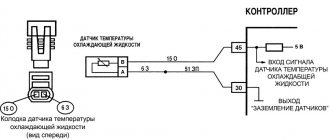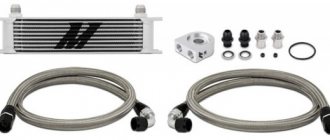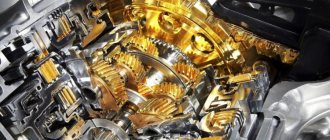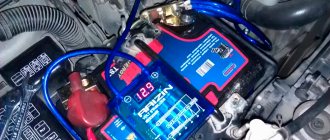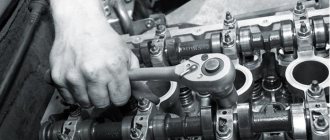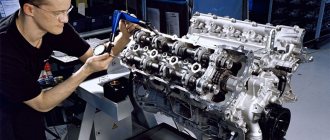After the appearance of the first internal combustion engines, the main task of designers and engineers from the very beginning was to increase the performance of the power plant. In other words, the main goal is to increase engine power. As you know, the simplest way is to physically increase the engine displacement and the number of cylinders. The engine “sucks” more air from the atmosphere, as a result more fuel can be burned.
At the same time, such power units with an increased displacement are large in size and weight, they are expensive to produce, it is not always possible to place such a motor in the engine compartment of a compact passenger sports car, etc. Another way to increase engine power is to build a unit that will “produce” the required power and torque without increasing the volume of the combustion chamber.
The problem can be solved by forcing air into the cylinders under pressure. To pump air into many internal combustion engines, turbocharging is used; another solution is a compressor (mechanical supercharger). In this article we will look at how a car compressor works on an engine, as well as what pros and cons a compressor engine has.
How does a compressor work?
In order to understand how this mechanism works, consider the operation diagram of a conventional four-stroke internal combustion engine. With the downward movement of the piston, a vacuum of air is created, which, under the influence of atmospheric pressure, enters the combustion chamber. Once air enters the engine, it combines with the fuel mixture and creates a charge that can be converted into useful kinetic energy through combustion. Combustion is created by the spark plug. Once the fuel oxidation reaction occurs, a large amount of energy is released. The force of this explosion moves the piston, and the force of this movement is applied to the wheels, causing them to rotate.
A denser flow of fuel-air mixture into the charge will create larger explosions. But it is worth understanding that burning a specific amount of fuel requires a certain amount of oxygen. The correct ratio is: 14 parts air to 1 part atmospheric air. This proportion is very important for the efficient operation of the car’s power unit and expresses the rule: “in order to burn more fuel, more air must be supplied.”
This is the job of the compressor. It compresses the air entering the engine, allowing large quantities of it to be filled into the engine and creating a pressure build-up. At the same time, more fuel can enter the engine, causing an increase in power. On average, the compressor adds 46% power and 31% torque.
The mechanical supercharger is driven by a drive belt wrapped around a pulley that is connected to the drive gear. The drive gear drives the supercharger gear. The compressor rotor takes in air, compresses it, and throws it into the intake manifold. The rotation speed of the compressor is 50 - 60 thousand revolutions per minute. As a result, the supercharger increases the air supply to the car's engine by approximately 50%.
Because hot air is compressed, it loses its density and cannot expand much during an explosion. In this case, it cannot deliver as much energy as is produced when the spark plug ignites a cooler fuel-air mixture. It can be concluded that in order for the supercharger to work at maximum efficiency, the compressed air leaving the device must be cooled. The intercooler handles the air cooling process. Hot air is cooled in the intercooler tubes using cold air or cold liquid, depending on the type of mechanism. Reducing the air temperature, increasing its density, makes the charge that enters the combustion chamber stronger.
Electrical wire length
The length of the electric wire and air hose should be sufficient to inflate any wheel. When choosing the length of the wire and hose, you should be guided by the length of the car and where you will connect the compressor: to the cigarette lighter or to the battery. There are compressors with a short wire and a long air hose, and there are compressors with a long wire and a short hose. It is best if the sum of the lengths of the electrical wire and the air hose is at least 5 meters.
Types of compressors
There are three types of compressors: twin-screw, rotary and centrifugal. The main difference between them is the way air is supplied to the intake manifold of a car engine.
Twin screw compressor
A twin-screw supercharger consists of two rotors within which air circulates. This design creates a lot of noise in the form of compressed air whistling, which is muffled by special engine soundproofing methods.
Photo. Twin screw compressor
Rotary compressor
A rotary supercharger is typically located at the top of a car engine and consists of rotating cam shafts that move atmospheric air into the intake manifold. It is heavy and adds significant weight to the vehicle. In addition, the air flow in this type of compressor has an intermittent structure, which makes it the least efficient compared to other types of compressors.
Photo. Rotary compressor
Centrifugal compressor
A centrifugal supercharger is the most effective for forcibly increasing the pressure inside a machine engine. It is an impeller that rotates with enormous force and forces air into a small compressor housing. Centrifugal force pushes air to the edge of the impeller, forcing it to leave its cavity at great speed. Small blades located around the impeller convert high-speed, low-pressure air flow into low-speed, high-pressure air.
Photo. Centrifugal compressor
Choosing the right device - what to pay attention to?
One cannot but agree that Chinese-made products are captivating because they are cheap. The driver ends up getting frustrated due to the sudden breakdown. To avoid getting into a similar situation, it is important to choose a compressor based on the characteristics of the device.
Performance
Performance is the value stated in each model's specifications. The parameter is measured in “liters per minute”. Budget models are slow. Inflating one wheel can take up to 10 minutes.
What capacity electric pump to buy depends on the purpose of use. For example, for regular pumping, a device with a value of up to 30 l/min will be sufficient.
For passenger vehicles with tires with a diameter of 12-16 inches, you will need an electric pump with a capacity of up to 30 l/min. For SUVs, it is better to choose devices with a productivity of up to 70 l/min. When it comes to trucks, you will need a powerful compressor with a capacity of 75-90 l/min.
Pressure
Most compressors are capable of delivering a pressure of 7-8 atmospheres. For a passenger car, a device with a pressure of 2-3 atmospheres will be sufficient. Thus, any compressor with a range of 3-7 atmospheres is suitable for passenger cars.
Despite this, there are piston models whose air density is 20 atmospheres. They are designed for SUVs and trucks.
Pressure gauge
A pressure gauge is an element that allows you to monitor tire pressure. Without a pressure gauge, you can only determine the indicators “by eye”.
Devices are divided into digital and analog. Budget models have an error in readings, so with their help it is not always possible to achieve the optimal value in a tire. To obtain an accurate result, you have to turn off the compressor. To avoid such inconveniences, you should buy devices with a digital pressure gauge. In most cases it shows the correct values.
Connection method
Compressors according to the type of connection are divided into two types: those with a built-in battery and those that are powered from the on-board network.
More durable models are devices that connect directly to the battery. Less powerful options operate from the cigarette lighter. The most productive ones are connected directly to the terminals.
Cord length
Many manufacturers try to save on production, so the cords are made flimsy and thin.
When buying a compressor, the driver should pay attention to the length of the cord, its flexibility and strength. The length should be such that the user can easily connect the device to all wheels of the car.
Advantages of the compressor
The main advantage of a compressor is, naturally, an increase in vehicle engine power. Experts consider mechanical superchargers to be slightly better than turbocharged engines because engines equipped with them do not have a delayed response to the driver pressing the gas pedal because mechanical compressors are driven directly from the engine's crankshaft. Turbochargers, in turn, are subject to lag, since the exhaust gases gain the speed necessary to spin the turbines only after some time has elapsed.
Continuous operation time
The optimal choice is compressors with a continuous operation time of at least 20-30 minutes. Budget car compressors often have a short time of continuous operation; after 10-15 minutes they need a break to cool down. If the maximum continuous operation time is exceeded and the compressor does not have overheating protection, it may simply burn out.
Disadvantages of engines
Since the compressor is started using the engine crankshaft, this slightly reduces the power of the power unit. The compressor increases the load on the engine, so the engine must be strong enough to withstand strong explosions in the combustion chamber. Modern automakers take this condition into account and create stronger units for engines designed to work in tandem with a compressor, which increases the cost of the car, as well as the cost of its maintenance.
Overall, superchargers are the most effective way to add horsepower, or power in other words, to a vehicle's engine. The compressor can add from 50 to 100% of power, which is why racers and fans of high-speed driving often install it on their cars.
Car pump breakdowns and the possibility of self-repair
Every owner of a car compressor has encountered a situation where it is necessary to inflate a wheel, but the pump does not turn on at all or suddenly stops working. This often happens due to a burnt-out fuse in the car’s fuse block or because of breaks in the power cable through which the pump is connected to the “cigarette lighter” socket in the car or directly to the battery .
Both of these faults can be easily fixed by the car owner with his own hands. To do this, in the first case, you simply need to replace the blown fuse, and in the second, visually or using a tester, find the location of the cable damage and connect the ends of the broken wires in any available way. If the newly installed fuse blows again, it most likely has a short somewhere and requires a more complex repair. The compressor can only be turned on after the fault has been found and corrected.
Another breakdown typical of any compressor is bleeding of air due to the hose connecting the pump to the car tire being worn out. In this case, the hose must be replaced.
Important! In cases where the cause of the malfunction is a fire in the electric motor winding, repairing the automobile compressor is impractical. This is due to the fact that the price of a new electric motor is about 80% of the cost of the finished product.
But there are also a number of malfunctions that are characteristic of this or that type of automobile compressor.
Diaphragm group pumps
Vibrating pumps rarely fail. In this case, the most vulnerable element of such a unit is the membrane (diaphragm), made mainly of rubber or elastic polymers. Long-term operation of the diaphragm pump is ensured by eliminating the possibility of moisture, as well as dust and dirt particles entering the compression chamber . Timely replacement of worn parts and assemblies is also essential. During operation, vibration pumps are most often subject to wear:
- diaphragms that can become stiff under low temperature conditions;
- gas valves;
- pressure limiters.
Piston pumps
The owner of a piston pump may also encounter a number of typical malfunctions specific to this category of compressors. Among them, the most common cases are when:
- the pump motor is running, but the compressor is not pumping air;
- there is no required pressure at the compressor outlet;
- the pump switches off spontaneously.
It is not difficult to eliminate these faults, but you will have to disassemble the compressor. This is done in the following order: first, unscrew the screws (4 pcs.) holding the crankcase cover and remove it, then remove the cylinder head, removing the fasteners located on the piston head. Next, you need to diagnose and, if detected, eliminate faults in the order given in the table.
| Malfunction | Cause | Elimination |
| A faulty valve in the cylinder head prevents the compressor from pumping air normally. | Factors causing malfunction: Ø wear or displacement of the sealing ring located under the valve; Ø valve plate breakage; Ø presence of dirt accumulated under the valve. | To determine the cause of the malfunction, it is necessary to remove the sealing disc with the valve from the cylinder head. Failed parts should be replaced, and the moved o-ring should be returned to its place. In addition, you need to get rid of existing contaminants. |
| Another malfunction due to which the compressor stops functioning normally is deformation of the piston ring seal. | Breakdown usually occurs due to overheating of the compressor. | To return the deformed part to its original shape, it must be treated with WD-40 or solvent 646. However, before proceeding with this operation, it is necessary to dismantle not only the sleeve jacket, but also the sleeve itself. After the sealing ring acquires its former elasticity, it is given its former shape, and then all the removed parts are returned to their places. By rotating the electric motor shaft, make sure that the piston in the sleeve moves correctly. |
| Spontaneous shutdown of the compressor may occur due to the activation of the thermal protection system. | This happens due to the loose fit of the sleeve to the walls of its shirt. | The existing gap is eliminated by simple modification, using a thin sheet of aluminum, for example, from a beer can. Having tightly wrapped the sleeve with this sheet, it is returned to its place with little effort. At the same time, heat removal will improve and spontaneous shutdown of the pump should stop. |
Spontaneous shutdown of the compressor due to the activation of the thermal protection system due to overheating of the device is not considered a breakdown . However, if, when starting the pump, in addition to the thermal protection tripping, the fuse simultaneously blows, this indicates a breakdown of the pressure control relay. This fault can only be corrected in a specialized workshop.
Compressors with pressure gauges
Operating a pump equipped with a pressure gauge is much more comfortable than its counterpart without a measuring device.
On a note! If a pressure gauge is not included with the pump, you can buy one yourself and install it directly on the hose. A standard pressure gauge is usually connected to the cylinder head.
Like any measuring instrument, a pressure gauge can suddenly, without any reason, fail. However, it may display unreliable data or not work at all. Then the pressure gauge needs to be replaced. If you purchased a measuring device with different connecting dimensions, when replacing, you can use an adapter with the corresponding threaded outlets.
Advice! Experienced car enthusiasts recommend purchasing a pressure gauge equipped with a mechanism for bleeding off excess working fluid. This will allow you to relieve excess pressure in the tire inflated with air by simply pressing the existing lever.
Adviсe
- Buy high-quality pumps from well-known brands in specialized stores. Ask the seller for a warranty card. Manufacturers usually provide a 1 year warranty.
- Carefully inspect the product: a high-quality pump has legible stamps and numbers, parts are free of defects (including burrs and notches). Make sure the cable has no cracks or other flaws.
- It is desirable that the compressor be compact and not too heavy.
- Do not buy piston compressors with a plastic piston - they quickly fail.
- When using a compressor, the engine motor must be turned on so as not to discharge the car battery.
- To care for the pump, it is enough to clean the hose fitting and the air grilles on the device body from time to time.
Additionally
Hose length – the longer the hose, the more convenient it is to work with the pump. In practice, a 1.5-meter hose is sufficient for domestic use. More productive models that are used in car repair shops have a hose length of 7 meters or more.
Important: the hose must withstand maximum pressure and maintain its elasticity in the cold.
It is desirable that the hose has a threaded fitting for secure attachment to the tire valve. The quick-release adapter that is sometimes used to connect the hose to the wheel should be corrosion-resistant (brass is a good option).
The length of the power cable – for comfortable operation of the device – is at least 2 m, and better – 2.5-3 m.
Important: the length of the hose and cable must be sufficient to inflate any wheel in the car.
Housing is the shell of the pump that protects its elements from external influences. Budget devices have a plastic case, while more expensive devices have a more durable metal case. Characteristics of a high-quality case: shock and low temperature resistance, fire resistance.
Availability of a receiver
A receiver is a device that allows you to accumulate air. Popular manufacturers of pumping equipment have in stock such models with a receiver of 3 liters or more.
These models are used:
- For tire fitting;
- For airbrushing;
- To create a car pneumatic system.
All these features will appeal to professionals. An example of such a device is the Aggressor AGR-8LT compressor. From the name it is clear that the receiver is designed to pump 8 liters.
Screw type
This is a more advanced and reliable supercharger design. The principle of operation here is also simple - compression occurs by changing the volume of the cavities between the body and the rotation screws (a kind of rotors). The air here moves diagonally. The big advantages of this option are high efficiency up to 85%, as well as high air pressure (from 1 bar to higher), this is achieved by high speeds, sometimes up to 12,000 rpm. It is because of this that the body can be made more miniature. It must be said that this option is often used on racing cars due to its reliability and small body.
The only downsides are the complex structure and repairs, which increases the price of the final product. If such a drive compressor fails, it needs to be repaired at specialized stations, preferably from the manufacturer.
As you can see in the design there are two rotors, with serrated spiral teeth. Their profiles fully correspond to each other when in contact, which makes the design very reliable.
TURBO - NOT TURBO
In short, there are now many design varieties of compressors. Some work using the energy of exhaust gases (TURBO), others - using a drive (NOT TURBO). It is the latter that we will talk about today. By the way , which is better, a turbine or a compressor, you can read at the link.
If you examine the design of such units, you can identify a certain similarity in structure. Namely, such compressors operate from a drive that does not require intervention in the standard engine systems, namely the lubrication and exhaust gas system, which is very important! This design is really very simple - a direct connection is established with the “crankshaft”, which allows the engine and supercharger to interact perfectly during acceleration. That is, the higher the speed, the faster the “crankshaft” rotates, and accordingly the supercharger spins! Thanks to this interaction, there is practically no such thing as “turbo lag”. Also, an additional advantage is the lack of operation at high temperatures, like with TURBO options, which means that the service life is greatly increased - after all, there is no need for the “turbine” to cool down, that is, “turbo timers” or “boost controllers” are not necessary, we just turn off the car and work stops. The site autoflit.ru recommends doing exactly the same. If you're interested, come in.


